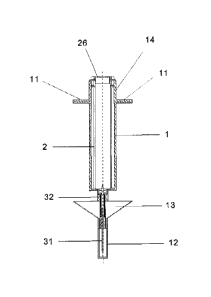Une partie des informations de ce site Web a été fournie par des sources externes. Le gouvernement du Canada n'assume aucune responsabilité concernant la précision, l'actualité ou la fiabilité des informations fournies par les sources externes. Les utilisateurs qui désirent employer cette information devraient consulter directement la source des informations. Le contenu fourni par les sources externes n'est pas assujetti aux exigences sur les langues officielles, la protection des renseignements personnels et l'accessibilité.
L'apparition de différences dans le texte et l'image des Revendications et de l'Abrégé dépend du moment auquel le document est publié. Les textes des Revendications et de l'Abrégé sont affichés :
| (12) Brevet: | (11) CA 2770939 |
|---|---|
| (54) Titre français: | SERINGUE MEDICALE AUTO-JETABLE DE BIOSECURITE |
| (54) Titre anglais: | MEDICINAL BIOSECURITY AUTO DISPOSABLE SYRINGE |
| Statut: | Octroyé |
| (51) Classification internationale des brevets (CIB): |
|
|---|---|
| (72) Inventeurs : |
|
| (73) Titulaires : |
|
| (71) Demandeurs : |
|
| (74) Agent: | FINLAYSON & SINGLEHURST |
| (74) Co-agent: | |
| (45) Délivré: | 2020-09-15 |
| (86) Date de dépôt PCT: | 2010-06-16 |
| (87) Mise à la disponibilité du public: | 2011-02-17 |
| Requête d'examen: | 2015-06-16 |
| Licence disponible: | S.O. |
| (25) Langue des documents déposés: | Anglais |
| Traité de coopération en matière de brevets (PCT): | Oui |
|---|---|
| (86) Numéro de la demande PCT: | PCT/ES2010/070401 |
| (87) Numéro de publication internationale PCT: | WO2011/018539 |
| (85) Entrée nationale: | 2012-02-10 |
| (30) Données de priorité de la demande: | ||||||
|---|---|---|---|---|---|---|
|
L'invention concerne une seringue de sécurité comprenant un cylindre (1) creux avec une paire d'ailettes (11) et un embout (12) dans lequel vient se loger le mécanisme d'injection (3), un piston (2) et un mécanisme d'injection (3) présentant une aiguille (31), un ressort (32) et une membrane (33), le piston (2) possédant une couronne (21) dentée au niveau de sa partie inférieure. On utilise un joint de chambre (22) qui ne se rompt qu'avec la pointe intérieure de l'aiguille (31), les extrémités du piston (2) possédant un disque inférieur (24) et un disque supérieur (25) qui stabilise le piston (2) à l'intérieur du cylindre (1). Autour du cylindre (1) se trouve une garniture de protection (13) contre les piqûres accidentelles. Le piston possède un bouchon (26) assurant l'étanchéité de la chambre vide.
The present invention relates to a security syringe comprising a hollow
cylinder
(1) with a pair of wings (11) and a tip (12), which houses: the injection
mechanism (3),
a piston (2), and an injection mechanism (3) with a needle (31), a spring (32)
and a
membrane (33). The piston (2) has a serrated crown in the lower part (21)
thereof
where a chamber seal exists (22) and breaks only with the interior point of
the needle
(31), having the ends of the piston (2) of an inferior disk (24) and a
superior disk (25)
that steadies the piston (2) inside the cylinder (1). Around the cylinder (1)
there is a
protective funnel (13) against accidental injections. The piston comprises a
cap (26)
which guarantees the hermeticity of the empty chamber.
Note : Les revendications sont présentées dans la langue officielle dans laquelle elles ont été soumises.
Note : Les descriptions sont présentées dans la langue officielle dans laquelle elles ont été soumises.

Pour une meilleure compréhension de l'état de la demande ou brevet qui figure sur cette page, la rubrique Mise en garde , et les descriptions de Brevet , États administratifs , Taxes périodiques et Historique des paiements devraient être consultées.
| Titre | Date |
|---|---|
| Date de délivrance prévu | 2020-09-15 |
| (86) Date de dépôt PCT | 2010-06-16 |
| (87) Date de publication PCT | 2011-02-17 |
| (85) Entrée nationale | 2012-02-10 |
| Requête d'examen | 2015-06-16 |
| (45) Délivré | 2020-09-15 |
| Date d'abandonnement | Raison | Reinstatement Date |
|---|---|---|
| 2016-06-16 | Taxe périodique sur la demande impayée | 2016-11-24 |
| 2017-07-12 | R30(2) - Absence de réponse | 2017-12-29 |
| 2019-10-01 | Taxe finale impayée | 2020-05-15 |
Dernier paiement au montant de 254,49 $ a été reçu le 2022-06-14
Montants des taxes pour le maintien en état à venir
| Description | Date | Montant |
|---|---|---|
| Prochain paiement si taxe applicable aux petites entités | 2023-06-16 | 125,00 $ |
| Prochain paiement si taxe générale | 2023-06-16 | 347,00 $ |
Avis : Si le paiement en totalité n'a pas été reçu au plus tard à la date indiquée, une taxe supplémentaire peut être imposée, soit une des taxes suivantes :
Les taxes sur les brevets sont ajustées au 1er janvier de chaque année. Les montants ci-dessus sont les montants actuels s'ils sont reçus au plus tard le 31 décembre de l'année en cours.
Veuillez vous référer à la page web des
taxes sur les brevets
de l'OPIC pour voir tous les montants actuels des taxes.
Les titulaires actuels et antérieures au dossier sont affichés en ordre alphabétique.
| Titulaires actuels au dossier |
|---|
| POVEDA ESTEPA, LUIS ENRIQUE |
| Titulaires antérieures au dossier |
|---|
| S.O. |